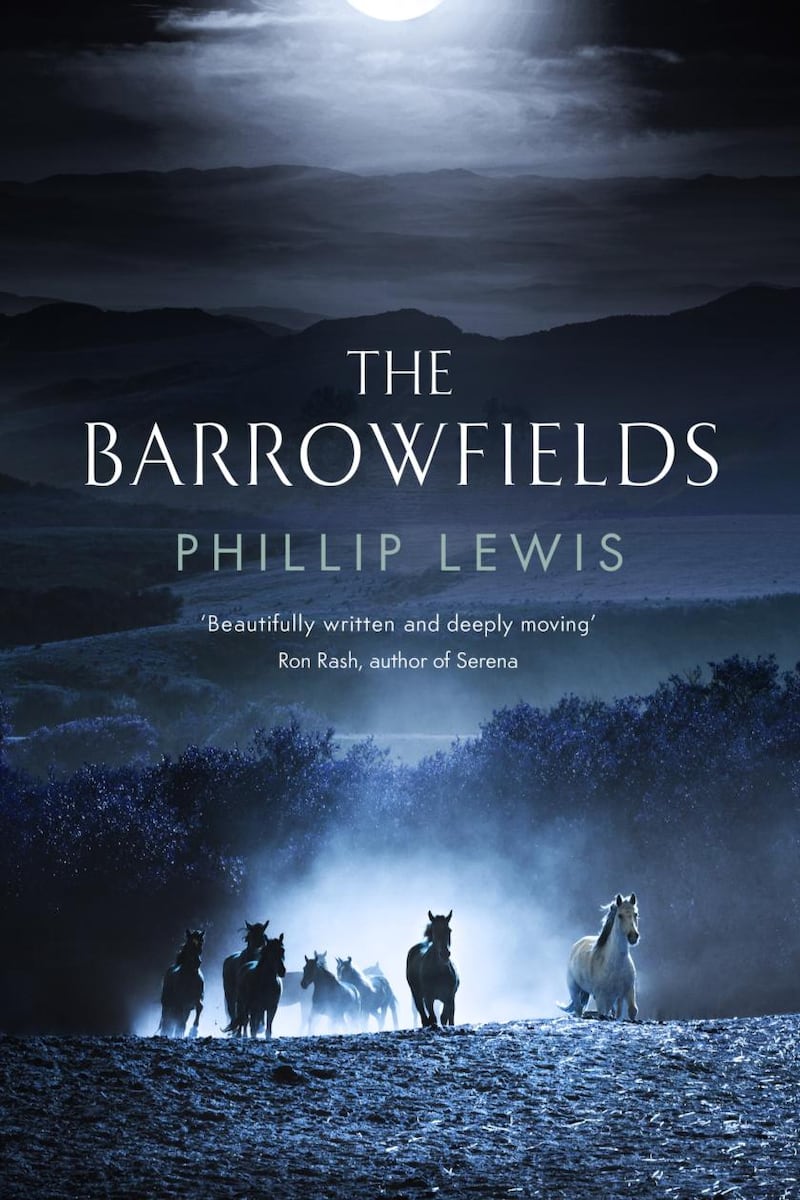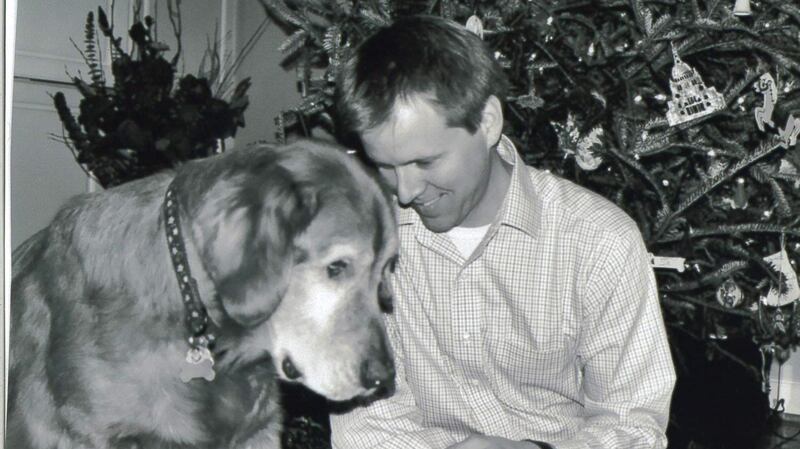Over the past several years, I wrote a book called The Barrowfields (Sceptre) that follows the lives and tragedies of the Aster family across the decades, set in the high Appalachian mountains and the historic low country of South Carolina. Having grown up in the mountains of North Carolina, I believed it critical in writing The Barrowfields to create an authentic account of the people and places in this region, staying true to their extraordinary dialects, nuances, and colorful complexities.
While The Barrowfields is undoubtedly a work of fiction, a few people along the way have asked me whether any of the characters in the book are based on real people, and the answer is generally no – except in the case of one remarkable dog by the name of Buller.
When I was in law school and living alone in an old mill town near campus, I decided the time was right for me to get a dog. My family always had dogs when I was growing up, and our dogs were, without fail, treated just as members of our own family, except that they were better cared for, and received more prompt medical attention than the children, which is entirely appropriate in my opinion.
In my search for a dog, I came across an advertisement in the local paper: golden retriever puppies for sale! Not knowing what I know now about the critical need to adopt unwanted pets rather than pets bred for sale, I used some of my education loan to purchase one. I visited the yard where the dogs were being kept, and one of them – a clumsy, roly-poly, but proud little guy with overgrown feet (comparable size-wise to what you’d find on a healthy snow leopard) – came straight over and claimed me for his own.

I had just finished reading Beryl Markham’s extraordinary book West with the Night, and thus when casting about for a possible name for my new friend, I hit upon Buller, which was the name of Beryl’s dynamic dog and cat-hunting avenger during her childhood years in east Africa.
My Buller was small for his age when we first met, but this condition didn’t last for long. He quickly grew into his feet and would eventually weigh in at a solid 125 pounds. At maturity he had a square jaw, a broad chest, and pranced about like a show horse, making him appear almost majestic – until you saw the stuffed animal he was carrying.
When he was a puppy, he maintained a dignified (if not haughty) air in my presence and managed to restrain the ordinary canine impulses often found in young dogs. When left alone, though, even for a moment, he became a whirling dervish of destruction, eating books, plants, legs of chairs, window sills, and literally anything within reach of his tireless golden mouth. He had rows and rows of serrated teeth like a shark (not really, but it seemed like it), and he used them to devour everything in his path.
Curiously, despite his tendency to behave like a wood-chipper with rabies, he never ate his own toys, and would gingerly carry his stuffed animals around like they were his newborn children
For a while I tried leaving him in a big comfy crate when I went to class during the day, but he hated it and became crazed and delirious anytime I’d motion him toward it or try to scooch him inside. I finally gave up and just assumed that a certain amount of property damage would occur each day during my time away.
Curiously, despite his tendency to behave like a wood-chipper with rabies, he never ate his own toys, and would gingerly carry his stuffed animals around like they were his newborn children. A friend of mine in law school once bought him a teddy bear, and Buller had it for years. He’d pick it up either by the nape of its neck or a paw, carry it to his bed, and just lie there cleaning it lovingly for hours. When he and I went out for a ride in the car, he’d make a frantic search of his toy box and bring it (or another suitable toy) along with him.
As Beryl wrote of her Buller, “He was my accomplice in everything.” Similarly, my Buller did everything with me, and he went everywhere I went. He’d lie under my desk while I studied and read my cases on constitutional law and contracts, and go with me to the grocery store when we needed food and beer.
One of his favourite things was to get a running-go and leap blindly through the shower curtain while I was taking a shower, an act that had unpredictable consequences and occasionally resulted in injuries to one or both of us. At night he’d bound up onto the bed with me and sleep with his head on my chest until morning.
More than anything, Buller loved to travel with me up to the mountains of North Carolina to the hilltop home where I grew up, and where my mother still resides. Our family home was surrounded by acres of horse pasture, and Buller would play outside in the yard and roll around in the grass and go on long, contemplative walks through the neighbouring woods.
In the valley below our house were two small cow pastures on either side of a narrow stream. On visits home, Buller often crept off down the hill and covered himself head to toe with fresh (ie, wet) cow manure, such that he was a completely different colour and almost unrecognisable. Wearing layers of caked excrement, he’d come trotting back up the hill thoroughly pleased with himself, and present his new adornments to me as if he’d just received a long overdue award.
When he was about two years old, he had his first seizure. We were playing in the front yard on a warm day and he was chasing tennis balls, and he just collapsed. Lying on his side, he became catatonic, and his legs were stiff. I didn’t know what was happening to him. The episode lasted for about two minutes and was utterly terrifying. A week later it happened again, this time on a walk through the neighbourhood. By the time we got to the vet’s office, he had recovered.
I hoped that these were just isolated incidents, but they weren’t. As he got older, he had more seizures, but not according to any visible pattern that I could detect. After trying every other remedy under the sun without success, his vet prescribed him phenobarbital that he had to take twice a day. I was told that the medicine would, over time, have negative effects on his health.
The phenobarbital seemed to reduce the frequency of his seizures, but it didn’t eliminate them entirely. If I were present when a seizure occurred, I would lie on the floor with him and hold him and talk him through it. When it was over, he would be dazed and disoriented for a moment, but then he would be up and moving around in no time as if nothing had happened. I always wondered what it must have been like for him. I hated to think about him having seizures when I wasn’t there to help.
Despite the seizures, he never slowed down. We had an extraordinary time. He saw the mountains and he played fiercely in the ocean, and we walked enough miles to circle the globe a dozen times.
One late-August day when he was nine years old and some white had grown into his whiskers, he didn’t eat his breakfast and wasn’t interested in his dinner either. When he refused his breakfast again the next morning, I began to get concerned that something was amiss. I wondered whether he’d chewed up and eaten a toy I’d recently purchased for him. My girlfriend and I took him to the vet that evening to be checked out.
They kept him in the back for what seemed like an eternity. Then a vet tech approached us and said, “We’re just running a few more tests.” After another hour, the vet came into the waiting room and started talking, but I couldn’t understand the import of what she was saying. “I’m sorry,” she began. “There’s a tumour . . . haemorrhaging . . .” I looked over at my girlfriend and saw that she was crying. It slowly came to me that something was horribly wrong, and that there was nothing that could be done.
The vet said it would be possible to do surgery, but that Buller would not likely survive it. She said any available medical procedures would be more for me than for Buller. They let him come home with us so we could say goodbye. After sleeping next to him on the floor that night, the next morning I held him and cried and looked into his eyes and told him goodbye for the first time and the last. The vet administered the life-ending concoction and he laid him down on the floor and it was over. Buller was gone.
Later that day I drove him up to the top of the hill where I grew up and, with my mother’s help, dug a hole in the yard near the fence where the raspberries grew and the phlox and the yellow sun drops and the purple irises shaded the grass. I knew he’d be happy there. We buried him with flowers.
I have never experienced grief so acutely as I did when Buller died, nor have I since. I couldn’t go home for days. He was always waiting at the front door when I opened it, ready to go outside and play. I just couldn’t bear the thought of opening the door without him on the other side of it. He died on September 2nd, 2009. Even after all these years, I still feel it like it was yesterday. I miss him terribly.
In my humble attempt to portray Buller in The Barrowfields, the one thing I changed was his breed. Since the short but glorious reign of Buller Copernicus, I have learned that, in the United States, there is what is known as an “unwanted pet problem”. As hard as it is to believe, hundreds of thousands of homeless dogs and cats are euthanised each year, with no end in sight. I understand why some people enjoy known breeds of dogs, but I will only have shelter dogs from now on.
So here’s to my dear Buller: the always brave, the proud, my best friend; the most loving, kindest soul I’ve ever known. You were tied to me, and me to you. I will never forget you, and now you will live on within the pages of my book.

The Barrowfields by Phillip Lewis is published by Sceptre in hardback this week, priced at £18.99














